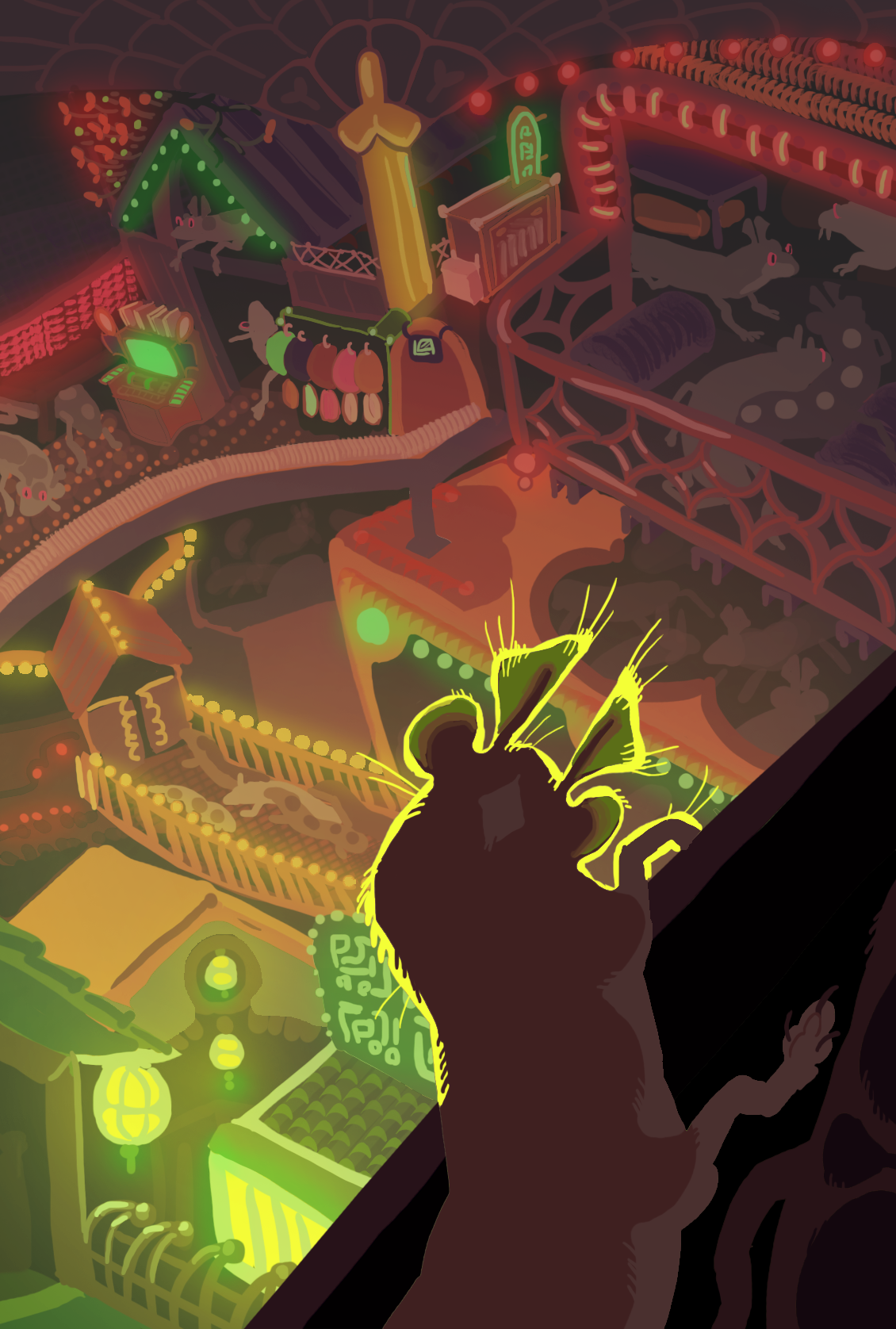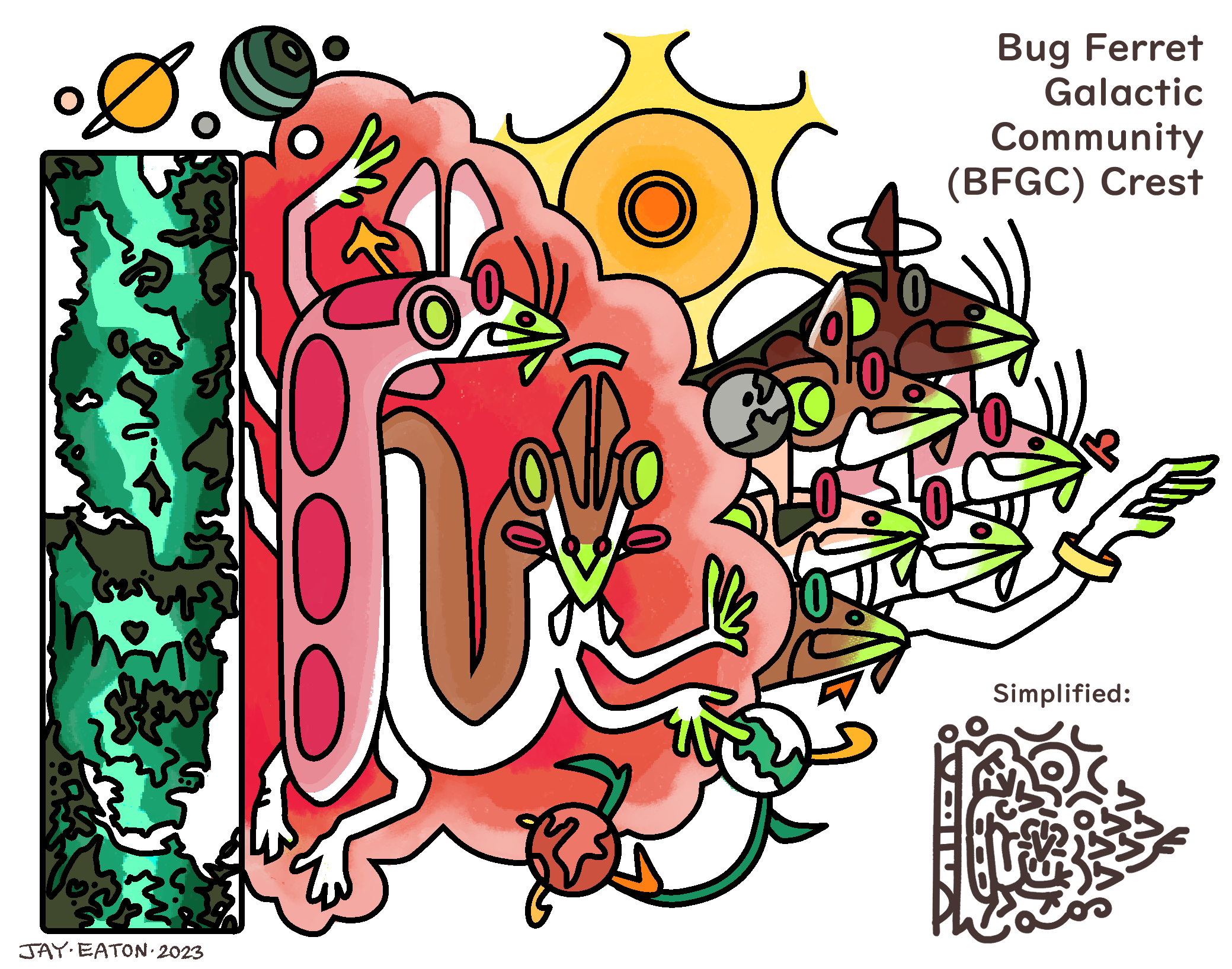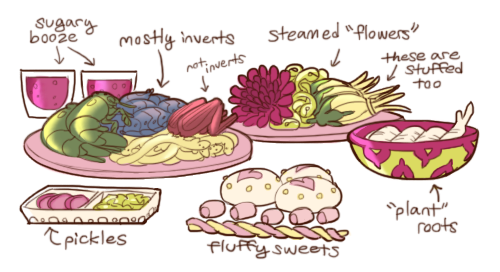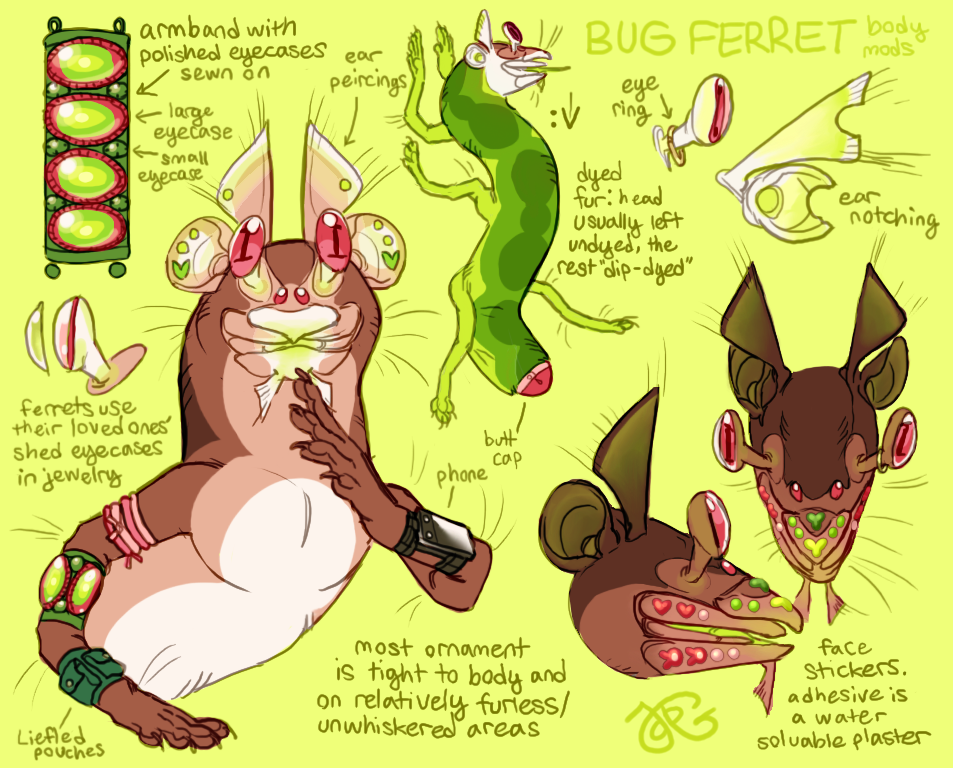
Bug ferrets usually live in family units of 15-45 individuals. A given family will usually all be in a single profession, operating almost like an individual– for instance, in public offices, a family will be nominated rather than an individual ferret. Having ferret ambassadors over on other planets is a nightmare, because you can’t just invite one ferret, or two, or eight, you have to have the entire family of 30 or so ambassadors (and their kids, and their picnic baskets and etc).
Culturally, they place a huge emphasis on collectivism over individuality. It can cause social clashes where ferrets will not trust a single sophont’s expertise or judgment, or other sophonts try to interact with ferrets by isolating an individual they’ve erroneously picked out as the group leader. The latter can lead to stress and confusion for the singled out ferret; because one ferret of a social group, family, or occupational committee is never responsible for governing all aspects of the group’s processes.
Bug ferrets in general do not cope well with being alone, but their society is built from the ground up to make it difficult to not be around other people. In cases where an individual ferret is isolated from communication other people, they become severely anxious. If the separation lasts more than a day or two, the ferret may start to have symptoms similar to those experienced by humans in extended solitary confinement, such as hallucinations, violent and paranoid outbursts, extreme hypersensitivity to sensory stimulus, self-harm, and worsening of their preexisting mental health problems.
In cases of pandemic/epidemic, families or districts are asked to quarantine rather than individuals– literally the government may shut off the area tunnels and switch them to isolated air ventilation. For day-to-day mildly infectious illnesses, it’s up to the family how to deal with individual sick ferrets. Usually, they are set up in the house’s medical room with limited physical contact but plenty of social interaction. A more strict family might put them in a room alone, but they would still generally be spoken to through the door and via instant messaging. That would still be a miserable experience for most ferrets, but it’s not true isolation.
Very generally speaking, ferret societies tend to have issues with devaluing the individual in legal and social systems, strict household role systems, and lack of treatment or tolerance for the mentally ill…
These issues also tend to stack. For instance, mentally ill ferrets are way more likely to be low in the family pecking order with very little control over the tasks and workload assigned to them. And if their illness severely affects their ability to do tasks for the family, they are likely to be divorced or disowned, and if you aren’t in a family you’re… kinda powerless, in addition to the toll loneliness usually takes on ferrets. In some places, an individual ferret can’t open a bank account or own property, they can only open it in either their married family or birth family’s name, giving anyone from that family joint control over the account/property. Predatory families in these cultures looking for some quick labor or worse will often snap up disowned ferrets desperate for basic legal protections. Sacrificing your individual needs and desires for the group you belong to is also expected in a lot of situations, a standard often exploited by predatory families to keep their abused members quiet and obedient.
Ferrets, being unisex, have no concept of sex-linked gender or homosexuality. There are a couple of family-role ‘genders’ they can choose from and switch between, like caretaker, manager, and worker; but it’s nothing like bisex species. The closest thing they have to an LGBT scene is asexual communities, and some sex-positive communities living in the more ‘sex is only for babies’ type ferret cultures.
What humans think of as typical schooling, ie, a teacher standing on a stage and lecturing a class, is virtually non-existent in bug ferret cultures. There is rarely a situation in which a young ferret is just being talked at by a teacher, reading plain text, or copying slides– nor is there a “school” location where pups are sent off alone for the majority of the day. Given ferret psychology, regular human public schools sound like a form of child torture!
Generally speaking, ferret youngins are educated by the caretakers in their families (which have up to 30 adults in various household roles), or in a group of nearby families’ caretakers and kids. Lessons are primarily taught in the form of hundreds of games and interactive objects. Most governmental districts have a standard set of lessons/games that must be taught to all pups, but many families supplement this with their personal favorites. In some areas, there are ferret families employed as government teachers, who go from neighborhood to neighborhood holding game sessions to teach state-required lessons. Field trips are also fairly common, usually as families taking their kids out for government-sponsored lessons at relevant locations.
Once the pups have grown up, they are ready to go out in small groups of peers to “colleges,“ where they can interact with more specialized teacher families. Colleges are basically just convention halls where teacher and trade families schedule meetings, and “lectures“ are a big educational moshpit where the host family and peer groups interact freely, usually with several learning games and interactive objects to keep everyone on topic. There is no strong equivalent to “homework“ in ferret schooling, but peer groups may be assigned projects or games to work on together in their off hours.

Ferrets also have an incredible propensity for language and seem to pick up other ferret languages and alien languages with ease, but they also have poor vocal flexibility compared to other sophonts. Although some spacefarers get cybernetic implants that allow them to speak alien languages, native bug ferret communication is a combination of visual sign, tactile sign, and expressive barks.
Unlike human sign languages, many bug ferret languages are made of non-representational syllables and can be spoken in complete darkness. Tactile signs are generally spoken by touching the arms, chin, and chest of the conversational partner. Humans have described it as “like the most intense and complicated game of pattycake you could imagine.”
In English, most bug ferret languages and institutions are named with abbreviations or translations because of the clunky nature of “transliterating” written sign languages.
The first alien language ever encountered by human linguists was spoken by the worker crew of the wormhole construction ship that appeared near Jupiter in 2195. It was actually not a common language, with a speaker base comparable to that of Finnish. Because of happenstance it is one of the most widely studied bug ferret languages in human linguistics.
The second alien language encountered by human linguists, BFL-2 has a speaker base of billions. It’s a constructed international auxiliary language, and similar to Esperanto, was created with the intention of being widely adopted and used to facilitate international communication. Unlike Esperanto, it was effective, and most of the bug ferret social world knows at least conversational BFL-2. Its sign name can be translated as We (International Group) Together Sign, but humans more commonly use “BFL-2” because it’s shorter.
Written BFL-2 uses smaller characters to describe handshape, motion, touch location, and repetition and combines them into larger “syllable” characters to describe different beats of motion while signing. The visual and tactile versions of the language are written the same, although in practice touch location is replaced with location in the air relative to the signer’s body.
Bug ferret internal politics are a Matryoshka doll of bureaucratic committees and overlapping political boundaries that seem to blur nations and polities together at the edges. They appear to lean authoritarian communist, but the exact delineations over who has authority over what seems to be constantly renegotiated by thousands smaller committees squabbling. Alien observers often find their systems impenetrably confusing and transient.
However, the outermost layer, and the committee that presents itself to other aliens in galactic politics, is the BFGC.
The Bug Ferret Galactic Community is an intergovernmental organization that represents the vast majority of bug ferret polities and institutions. Bug ferrets are the population supermajority of the galaxy, as they've been in space far longer than the other sophonts. They are also the only known so far to have independently developed any kind of FTL, wormhole interstellar travel. Although they are transparent about how the vast majority of their technology works, new wormholes necessarily have to connect to their established system of wormhole transit hubs to be worth the investment to build. These combined issues have led to the BFGC tending to get their way on most galactic politics, and although they are generally non-aggressive, this causes political tension.
Some of the tension in fact comes from their non-aggression, and ferret taboos about physical violence. When two non-ferret factions escalate a conflict to overt war, the BFGC is quick to withdraw technology support and wormhole connectivity in a way designed to make the war as inconvenient as possible, often to disastrous effect. Despite this, espionage, cold wars, and less explicit forms of violence are often ignored by the BFGC.

The BFGC crest depicts the habitable tropics of the bug ferret homeworld, and the avatars of their planet (brown and white ferret with a teal band overhead) and their large moon (pink spotted ferret with an orange fungi) surrounded by a pink cloud representing their relationship as egg twins in Star Family mythology. The homeplanet is shown transferring life to their sibling, who is imagined as having been a stillborn that was returned from death by terraforming. The six other ferrets represent the inhabited celestial bodies of the local star system. There are some expanded forms of the BFGC crest that include avatars of more or all of the inhabited worlds in their territory, which can get ridiculously large. Bug ferrets can only see red through green on the visible light spectrum, meaning their blue gas giant and bodies of water are depicted as a dark, grayish green.
Like other ferret crests, it can be represented in any style between painted realism and a “Braille” form; simple grooves that are easier for touch identification in total darkness. Bug ferrets do not use flags to represent political factions— they are accustomed to windless underground tunnels and tend to have poorer long distance vision than other sophonts, making “legibility at a distance” unimportant to them.
Ferrets are capable of processing much more sensory data simultaneously than humans are, so their visual media and graphic design tends to be extremely busy.
Ferrets are also big on rhythm in music. Drumming with the hands is a common idle activity, and musical junctions will have everyone pounding on the floor and each other in time to the beat. In their opinion, the best kind of music is the kind where you can feel the base vibrating your brains to jelly; they have some fancy high tech ‘ballrooms‘ where the floor is specifically designed to bounce to the beat. It’s overstimulation central for anyone who is not a ferret.
They also have a huge emphasis on interactive art. Flat paintings and pictures are rare, sculptures have moving parts, games and video games are high art, and they have bigger and weirder performance art than humans could ever dream of. Traditional theater thrives even after TV because ferret theater is very interactive. Audience interaction in ferret theater ranges from audience poll on plot decisions, to the entire audience being free to interact with characters during the play… the play here being essentially a room you walk into with actors in it, but a handful of aspects in it out of the audience’s control to drive the plot (usually actors on balconies, “world events” being announced by loudspeaker, or backdrop changes.)
Video media is no less chaotic. Most famous are ferret “soap operas,” live dramatic performances where the whole cast will talk and sign at once and the camera has a short attention span, not to mention overlays. Crammed onto the screen around the main content will be any number of extra camera views, director commentary, live studio audience, cross promotion, live translations, subtitles, funny animations, and character asides. Without a ferret brain and eyes that can point in independent directions, keeping up with the action can be a chore.

Although they are majority herbivorous with a diet full of fruit, fungi, chemosynthetic “plant” products and other produces, bug ferrets will also eat animals and animal byproducts, mostly invertebrates and smaller creatures. They also have a huge sweet tooth and are well equipped to eat lots of sugar; the ferrets’ immediate ancestors were pollinators and frugivores. Their typical snacks are sweets and bugs.
As for meat, ferrets usually eat their bugs roasted, not live, because their guts are adapted to eat cooked and processed foods like humans. Other methods of processing they use are smoking, canning, pickling, candying, and dehydrating. Most of the hard foods they create are intended to be rehydrated before consumption…. Although they can chew, they have no lips to form a seal with and not a ton of saliva, so grinding down on jerky or sucking on hard candies is slobbery and inconvenient. They also have many popular sugary alcoholic beverages, but can’t get drunk. Alcohol is just a fun spicy flavor to them.
Bug ferrets are almost always naked! Most clothes don’t agree with their sensitive whiskery hides, so they’re only ever worn when conditions make it necessary. E.g., in extreme cold and heat, certain cultural ceremonies, industrial environments, space, etc. In their day to day lives they may wear bags, pocket holsters, jewelry, and electronics (watches, phones, etc). The most clothed part of them at any point in time is probably their limbs, as many ferrets decorate with tight-fitting bracelets, pouches, and electronics in between the whisker nodes on their legs. The only “real” article of clothing regularly worn by ferrets is the butt cap, which is intended for decency and hygiene, but it is usually only seen for medical conditions or in more conservative cultures.

Ferrets are not as interested in their individual self image as the other aliens are, and have different reasons for and attitudes towards body modification. A modification is usually used as a family identifier, so if a ferret has say, given themselves 6 pink ear piercings, it’s likely that everyone in their current family group has 6 pink ear piercings. Imagine if everyone in your birth family dyed their hair green, and then when you went steady with the poly-group you date, you all dyed your hair blue. Other such family body mods include ear-notching and small non-obtrusive rings around the eye stalk. Less permanent body decoration, like bracelets, makeup/facepaint and mandible stickers, are usually more up to an individual’s tastes, and mostly seen at fancy junctions and on special occasions.
Bug ferret spacefaring and terraforming technology is more advanced the other sophonts, and although they have been more than eager to bring wormholes to new systems and assist in terraforming exoplanets for habitation, suspicions abound about how much bug ferrets aren’t telling their neighbors, and how much control they retain over tech they share. The reason for their advantage is likely just time, as they are from an older star that evolved sapient life earlier than comparable planets.
Bug ferret religions tend to have a huge amount of associated stories, multiple religious texts, hundreds of gods with dozens of roles within a pantheon, fantastic beasts of varying holiness and horribleness, and lots of squabbling over which of the many books and stories are canonical. Religious institutions are frequently more involved in media than government, and many playhouses, gaming halls, and libraries are run or sponsored by local religious groups. Holidays tend to be many, and frequently used as excuses to dance, socialize, and eat themed foods.
Breakaway sects from major modern religions that take faith more seriously are often just more pious partiers, but extremist groups are at risk of becoming cults. Bug ferrets are less inclined to violent us-vs-them psychology than humans, but abusive power structures tend to form within strict social groups. Because of the individual being devalued in favor of group health and strength, half or less of a group being bullied can sometimes be difficult to address or even recognize by other ferrets.
A popular mythos in the modern day for bug ferrets is the Star Family, a syncretic belief incorporating stories from several different religions, modern astronomy, and crest heraldry. It personifies their homeplanet and its large barren moon (technically the two form a binary planet system) as egg twins, and the moon as being stillborn. The homeplanet, in their sorrow and loneliness, created life on their back to keep them company. When bug ferrets then developed spacefaring technology and began to terraform their moon, they were bringing their planet’s sibling back to life and adding a member to their family. Every new planet colonized and terraformed is another member for the star family, bringing their homeplanet joy.
This mythos has made bug ferrets strong proponents of galactic exploration and terraforming barren worlds, but has resulted in complicated politics when it comes to other sophonts and their territories. Some ferrets view sophont territories as members of that same bug ferret star family, and since no sophont yet encountered has had technology as advanced as them, they often also see them as children to tutor. Ideologues of this sort advocate for paternalistic control and meddling in other sophont’s politics when they exhibit “bad behavior.” Other sects of bug ferret politics prefer to view the other sophont’s territories as neighboring star families, who do not need to behave as a bug ferret family member would be expected to inorder to be a respected member of the galactic community.